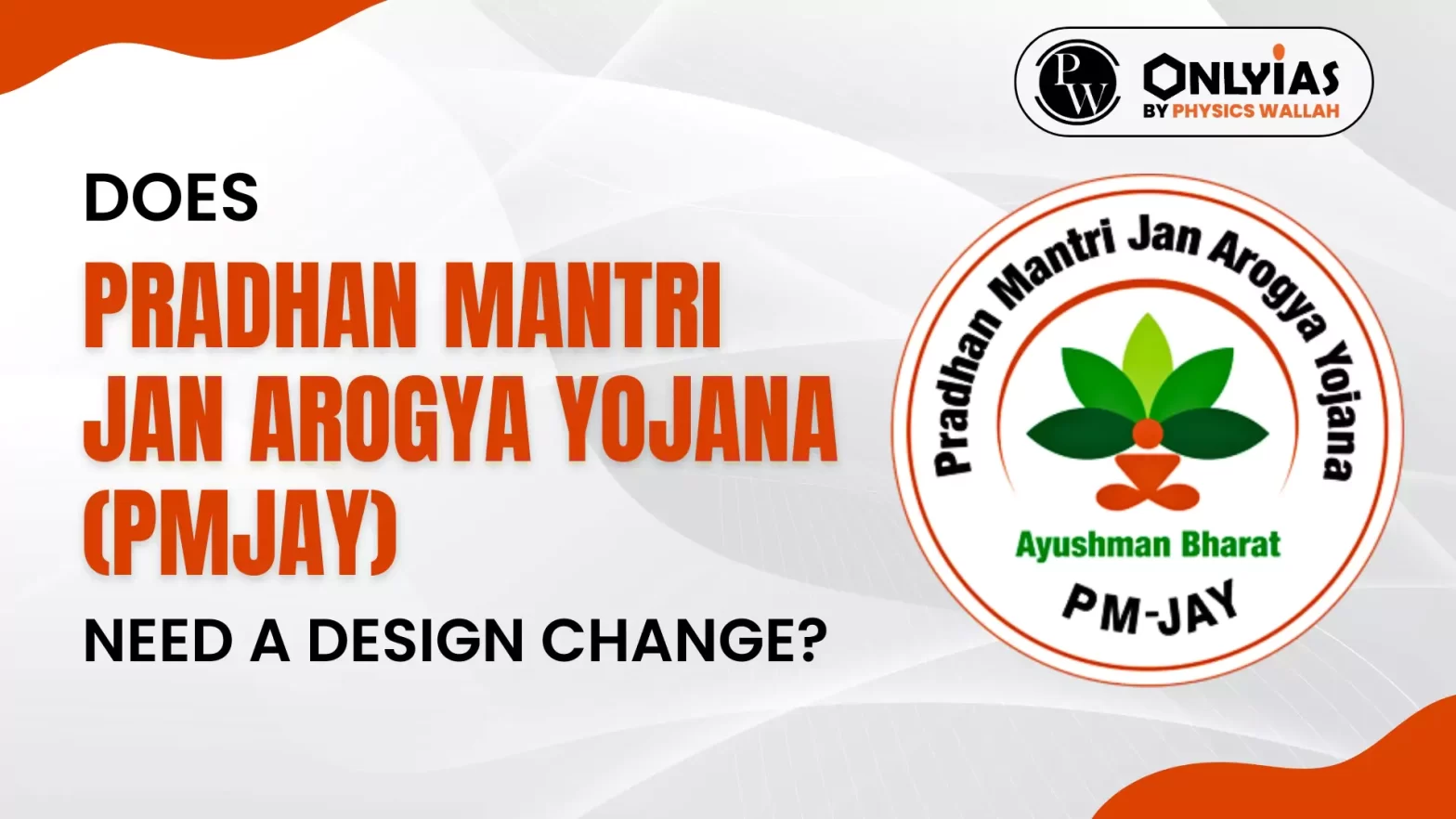Context
Recently, concerns arise regarding Pradhan Mantri Jan Arogya Yojana (PMJAY’s) sustainability, especially as some hospitals in certain states report significant outstanding dues and reduced acceptance of PMJAY patients.
About Pradhan Mantri Jan Arogya Yojana (PMJAY)
- Components of Ayushman Bharat: Ayushman Bharat, initiated in 2018, comprises two main components: health and wellness centres and the Pradhan Mantri Jan Arogya Yojana (PMJAY).
- Aim of the Scheme: PMJAY aims to provide a health cover of ₹5 lakh per family per year for secondary and tertiary care hospitalization to over 12 crore families that form the bottom 40% of the population.
- Target Achieved: As of now, PMJAY has issued 34.27 crore cards, facilitated treatment for about 6.5 crore individuals, and enlisted over 30,000 hospitals.
Enroll now for UPSC Online Course
Supply Side Perspective
- Private Sector Role in Healthcare Access: There’s acknowledgment of the importance of allowing patients to access the private sector due to perceived deficiencies in the public sector’s ability to provide universal healthcare.
- Challenges for Comprehensive Coverage: Current expenditure on PMJAY remains minimal, constituting less than 2.5% of total health expenditure, raising doubts about its capacity to achieve comprehensive coverage.
- Challenges Public Healthcare System: The reason we see high out-of-pocket expenditure in Kerala, for example, is that the public sector, despite being well funded, is unable to deliver universal healthcare.
- Its primary care is underutilized and there is enormous waste and inefficiency.
- Healthcare Access Concerns: Concerns are raised about the potential misallocation of government resources and the emergence of barriers, even within the public sector, which may hinder access to healthcare for low-income families.
- A high-income family can handle a claim rejection or delay, a low-income family cannot.
Demand Side Perspective
- Lack of Trust in Public Healthcare: The preference for private hospitals over public ones reflects a perception of better quality care, potentially indicating a need to enhance trust in the public health system.
- Empanelled hospitals are 43% private, and the rest are government.
- High Patient-to-Provider Ratios: In many States, the number of people per empanelled healthcare provider (EHCP) is really high.
- In Bihar, it was over 10,000 families per EHCP. There is a shortage of adequate number of beds and facilities to be able to cater to that demand.
- Private Sector Challenges: Challenges faced by the private sector, such as capacity limitations, delays in claim payments, claim rejections, and capped treatment charges, hinder effective implementation of PMJAY.
- Impact on Private Facilities: Lack of faith in the public health system drives patients towards overburdened private facilities, exacerbating costs and quality concerns.
Performance Disparity Among States
- Inactive Hospitals: Disparities exist among states in terms of hospital activity levels, with some hospitals remaining inactive since empanelment.
- In Uttar Pradesh, for instance, 39% have been inactive since empanelment, and only 50% have been active in the last six months.
- Variations in Coverage and Hospital Distribution; Differences are observed in coverage rates, hospital dispersion, and claim payment delays, necessitating further research to understand underlying factors contributing to performance variations.
- In terms of claim payments, some States saw a delay of more than 45 days, while others paid the claims faster.
- There is a concentration of claims in Andhra Pradesh, Arunachal Pradesh, Rajasthan, Karnataka, Maharashtra, and Tamil Nadu.
- Drivers of Disparities: While technological platforms enable claim processing, deficiencies in hospital capacity, particularly in Northern and North-Eastern states, contribute significantly to performance discrepancies.
-
- Lack of network adequacy requirements for insurers exacerbates challenges, as cards are issued without ensuring accessible healthcare facilities.
Addressing Out-of-Pocket Expenditure
- Pradhan Mantri Jan Arogya Yojana (PMJAY) Coverage Gaps:While PMJAY aims to mitigate healthcare cost shocks, its current design may not comprehensively cover outpatient care, diagnostics, and drugs.
- Towards Universal Health Care: Alternative state schemes like those in Tamil Nadu and Rajasthan offer insights into providing some form of universal healthcare, indicating the need for a broader perspective.
- Global Ranking: India is ranked 67th out of 189 countries in terms of out-of-pocket expenditure.
- PMJAY Funding Allocation Gap: The Union government is meant to allocate 60% of PMJAY funds, but the amount it is actually spending is less than this.
Insurance Model and Universal Health Coverage (UHC)
- Evaluating the Insurance Model: While the insurance model has been instrumental in delivering universal health coverage in several countries, its effectiveness in the Indian context warrants scrutiny.
- Lessons from Global Context: Countries like Thailand, Turkey, Vietnam, and Uruguay have leveraged insurance models to achieve UHC, but India’s approach requires careful consideration due to its unique healthcare landscape.
- Enhancing Public Sector Performance in Insurance:Restrictions on insurance to the public sector could potentially enhance performance, especially in poorer states, but broader reforms focusing on payment structures and non-price mechanisms are crucial.
- Revamping PMJAY for Comprehensive UHC: Rethinking PMJAY’s design is crucial to align with broader UHC objectives, emphasizing integrated financing mechanisms and strengthened primary healthcare infrastructure to reduce out-of-pocket expenditure and improve health outcomes for all citizens.
Enroll now for UPSC Online Classes
Conclusion
Enhancing trust in the public health system, reevaluating the insurance model, and adopting a holistic approach to healthcare delivery are essential for achieving sustainable and comprehensive universal health coverage in India.
Also Read: Ayushman Bharat Health Insurance Scheme
![]() 3 May 2024
3 May 2024

